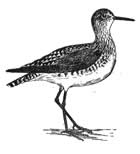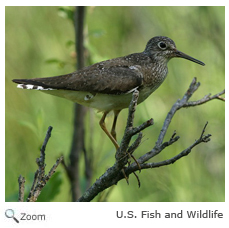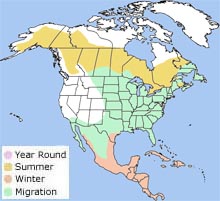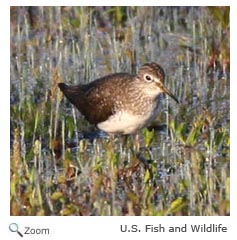Solitary Sandpiper - Tringa solitaria |
|||||||||||
Description
Range |
Habitat
DietThe solitary sandpiper forages in shallow water and skims food up from the surface of the water. It eats insects, larvae, small fish, tadpoles, frogs, spiders, and worms. It often shakes its foot to stir prey up to the surface of the water. Occasionally, it probes in the water for food, and it also forages for food on land. Life CycleThe male selects the nesting site. He chooses an abandoned nest of songbirds like American robins, rusty blackbirds, eastern kingbirds, gray jays or cedar waxwings. The nest is usually in a conifer tree, sometimes as high as 40 feet above the ground. The female may rearrange the nest after the male selects it. She lays 3-5 eggs. Both parents incubate the eggs for 23-24 days. The chicks are precocial and leap from the nest shortly after hatching. BehaviorThe solitary sandpiper and the green sandpiper of Eurasia are the only species of sandpipers that nest in trees! |
||||||||||
Audio Credit: xeno-canto.org Juan Mazar Barnett |
|||||||||||



 The solitary sandpiper breeds
across Alaska and Canada. It
The solitary sandpiper breeds
across Alaska and Canada. It 